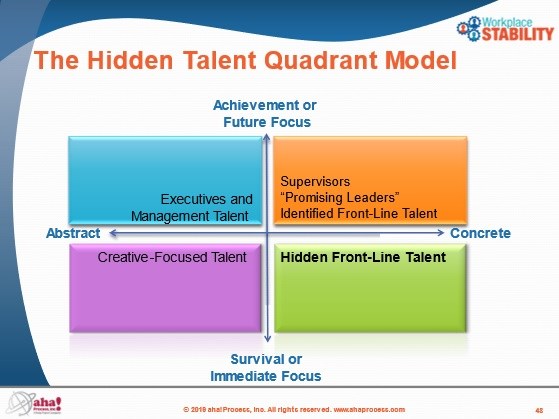
I Need Technical Employees!
Some of your employees process information abstractly, while others process information concretely. Employers need both.
The vertical axis shown on the accompanying graphic is about the forces that drive people’s mindsets and behaviors. This relates back to the environment in which people were raised, how they spend their time, and what their motivation is.
The horizontal axis shows how people digest information, how people break down information, and how people arrange and use information. Individuals who live in daily instability often think concretely. Abstract thinking is not the dominant form in an unstable environment. When people think concretely, they are dealing with objects and/or events available to the senses. At work, this might be a forklift, conveyor belt, computer scanner, etc.

When employees think abstractly, they are dealing with ideas, concepts, and terms used to represent concrete steps or plans. This might take the form of a marketing plan, an initial public offering, or a profit/loss statement. Businesses operate with an abstract orientation. If an employee has only processed information from a concrete perspective when all information at work is given abstractly, there will be a huge disconnect.
Employees who think concretely are most often employees from daily instability. Those who think abstractly are often those who lead the business, develop long-term strategies, and negotiate deals that keep the company at the forefront of its particular industry.
If you have employees who process information and complete tasks differently, this may very well be the difference between processing information abstractly and concretely.
The vertical axis represents the influence that the two different driving forces have in the workplace: stability in the future story at the top, and relative instability at the bottom. This information shapes how employees are thinking and living and where their mindsets are when they are at work.
If you have employees who process information and complete tasks differently, this may very well be the difference between processing information abstractly and concretely. The difference can impact discipline policies, conflict resolution procedures, explanations of benefits packages, etc., and an understanding of the difference may help avoid misunderstanding.
The utility of the abstract/concrete axes is that when you think of employees, you can see which quadrant(s) they fit into—this information can be helpful in the mentoring and job-coaching process. Managers and human resource professionals can use the information to guide an employee into another quadrant and role based on corporate initiatives. The tool fits nicely with personality tests that may already be in use in the hiring and promotion process.
While employers can benefit from adopting the concrete language of their employees from daily instability, they should also remember to model abstract speech so employees develop the ability to use both.
According to the research, employers tend to hire the same demographic of employee that they let go. Let’s keep and develop the employees we have.
About the Author: Ruth K. Weirich, MBA, is an author, trainer, and management professional experienced in business operations efficiency and profitability. She is also a past president of aha! Process, an education and training company specializing in economic class issues. Contact: rkweirich@ahaprocess.com; ahaprocess.com.

Leave a Reply